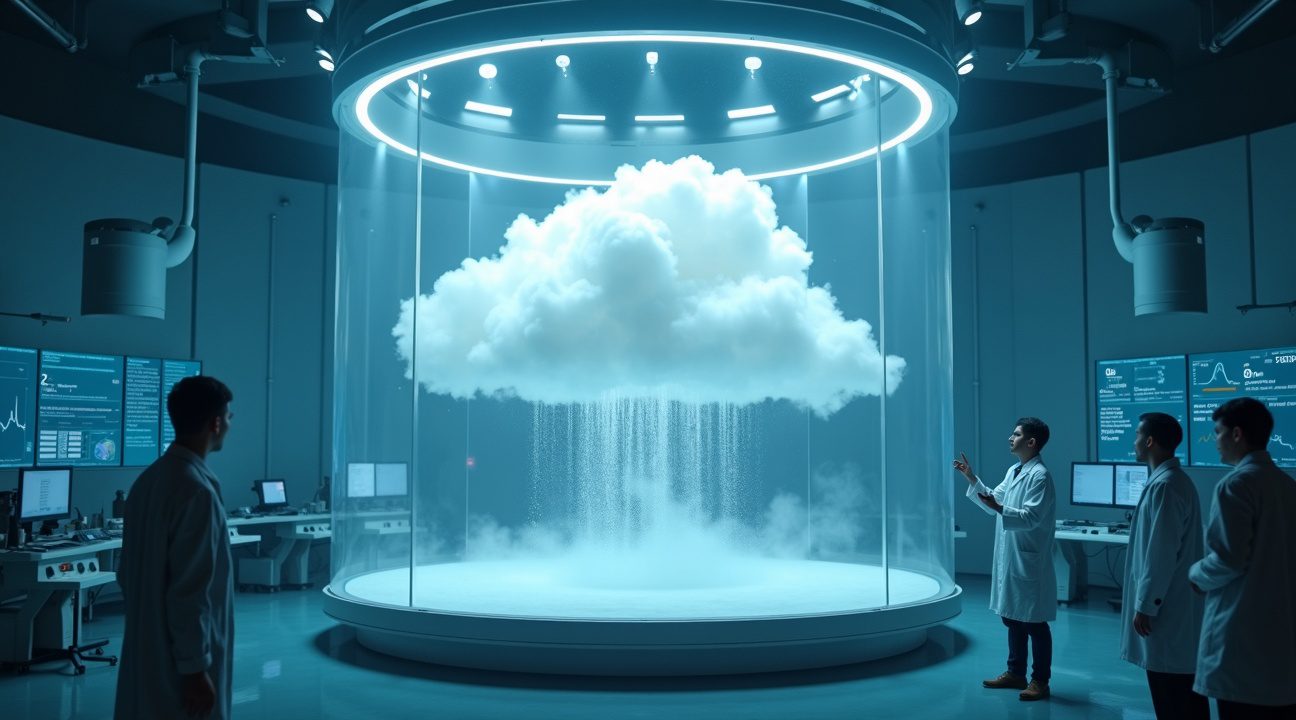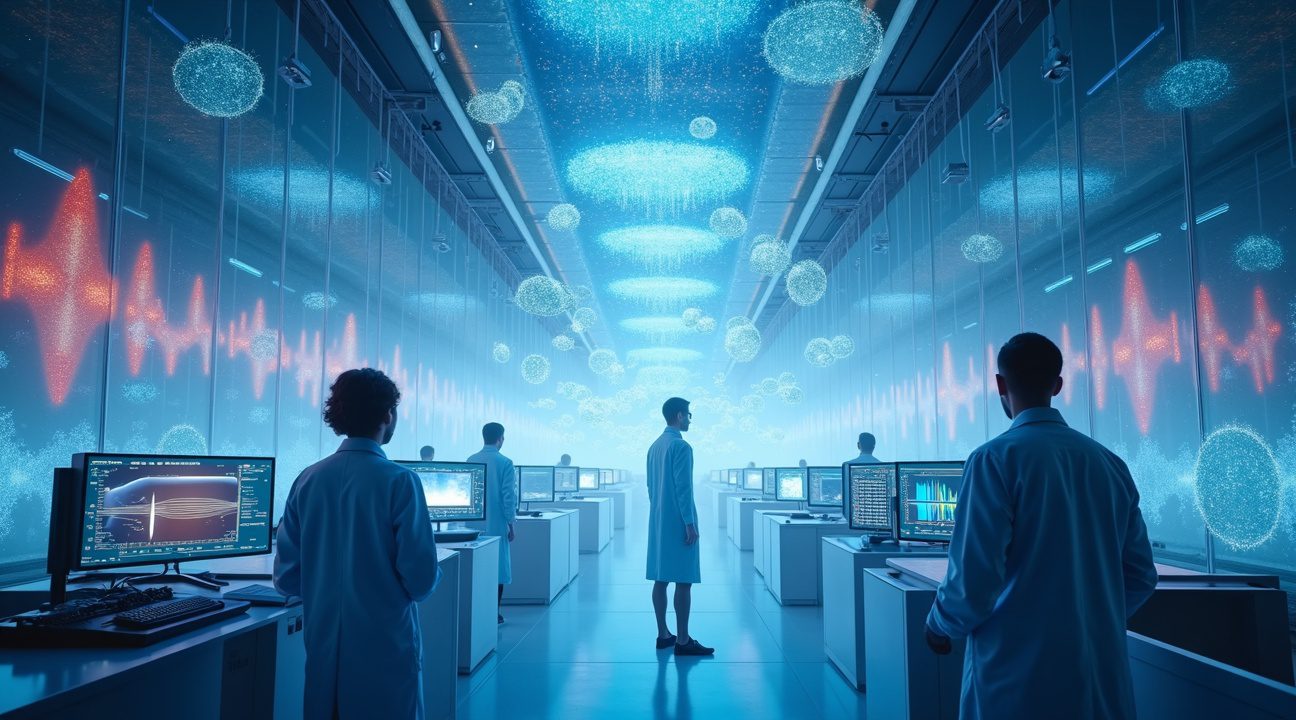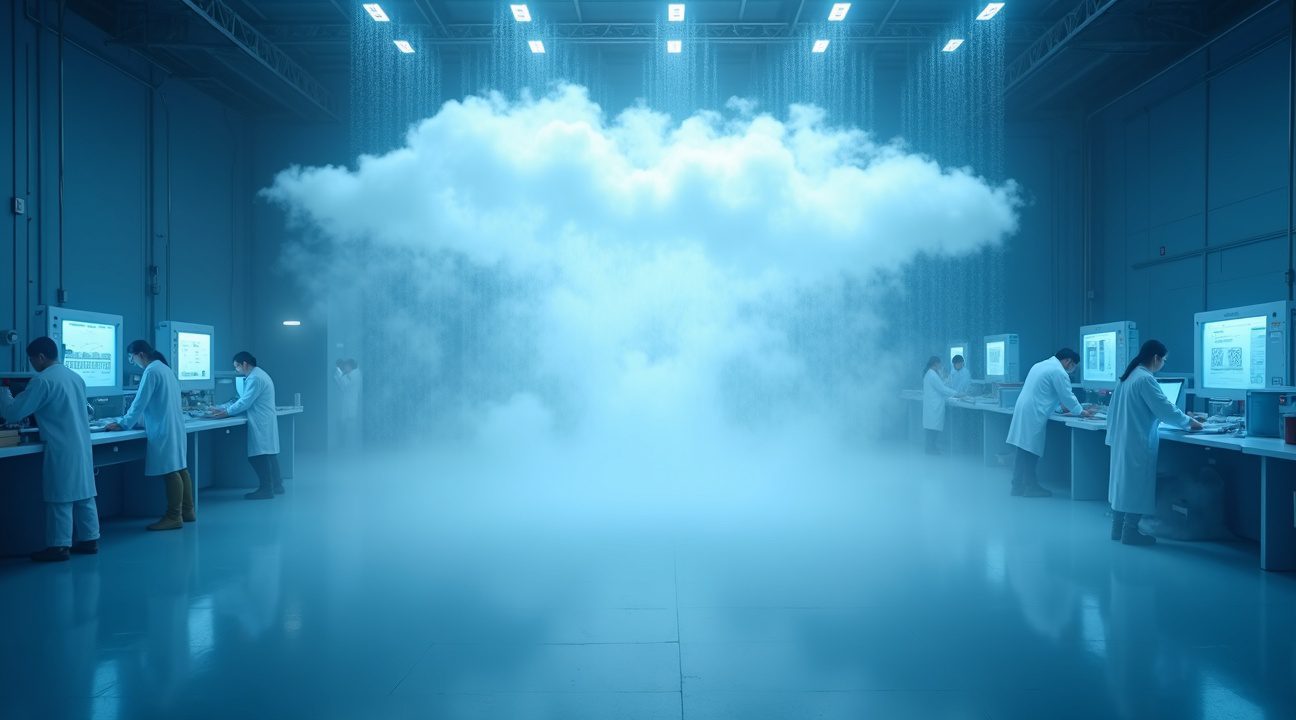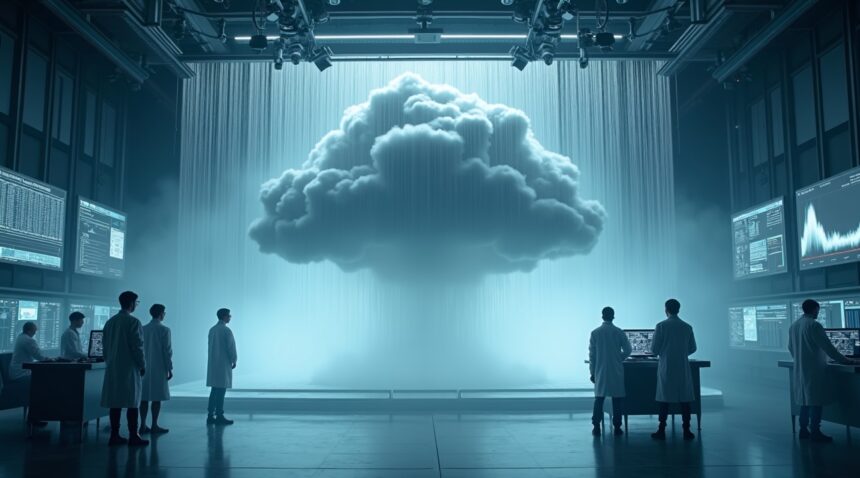Dutch scientists have made a groundbreaking achievement by engineering artificial clouds inside laboratory chambers that can produce real rainfall—enabling the scientific study of how sound frequencies impact droplet formation and precipitation patterns.
Key Takeaways
- Controlled cloud creation – Researchers precisely manipulate temperature, humidity, and introduce smoke particles to create authentic nimbus clouds that actually rain indoors for scientific observation.
- Sound wave effects on droplets – Different acoustic frequencies can accelerate or slow droplet coalescence, with higher frequencies breaking droplets apart and lower frequencies encouraging them to merge more rapidly.
- Advanced monitoring technology – High-speed cameras capture microscopic droplet interactions at thousands of frames per second while specialized sensors measure changes in particle density and collision patterns.
- Weather prediction applications – Laboratory findings could improve forecast accuracy by incorporating acoustic factors into weather models, especially for urban environments with constant noise pollution.
- Potential precipitation control – Research opens possibilities for developing acoustic-based technologies to encourage rainfall in drought-stricken areas or disperse fog using targeted sound frequencies.
Creating Controlled Clouds Indoors
The research facility creates authentic weather conditions inside controlled chambers. Scientists adjust temperature gradients and humidity levels with precision instruments. Smoke particles serve as condensation nuclei, mimicking natural atmospheric particles that allow water vapor to form droplets.
Using Acoustic Frequencies in Weather Simulation
Sound generators produce specific frequencies ranging from low bass tones to ultrasonic waves. These acoustic waves interact with forming water droplets in measurable ways. Lower frequencies create pressure waves that push droplets together, accelerating the coalescence process. Higher frequencies produce rapid vibrations that can shatter larger droplets into smaller fragments.
High-Speed Monitoring and Sensory Equipment
High-speed photography reveals droplet behavior invisible to the naked eye. Cameras operating at 10,000 frames per second capture collision events lasting microseconds. Laser measurement systems track individual droplet paths through the artificial atmosphere.
Temperature sensors throughout each chamber monitor thermal variations down to hundredths of degrees. Humidity gauges measure moisture content changes as droplets form and fall. Pressure sensors detect acoustic wave propagation through the artificial cloud environment.
Eliminating Atmospheric Variables
The controlled environment eliminates variables that complicate natural weather observation. Wind patterns, solar radiation, and atmospheric pressure changes don’t interfere with acoustic measurements. Scientists can repeat experiments with identical conditions to verify results.
Urban Noise and Weather Implications
Urban noise pollution creates constant acoustic interference in city atmospheres. Traffic sounds, construction equipment, and industrial machinery generate complex frequency patterns. These man-made sounds could influence precipitation formation over metropolitan areas in ways meteorologists haven’t previously considered.
Implications for Climate and Weather Engineering
The research suggests targeted acoustic intervention might enhance rainfall in specific regions. Sound arrays positioned strategically could theoretically encourage droplet formation during marginal weather conditions. Conversely, ultrasonic frequencies might disperse fog around airports or highways for improved visibility.
Applications in Agriculture and Environment
Agricultural applications appear promising for drought management. Acoustic systems could supplement cloud seeding operations by encouraging existing moisture to precipitate more efficiently. The technology might prove more environmentally friendly than chemical cloud seeding methods currently in use.
Future Research and Possibilities
Scientists plan to expand their research to include different cloud types and atmospheric conditions. Mountain weather patterns, coastal fog formation, and storm development all present opportunities for acoustic weather modification research. Each environment requires different frequency ranges and power levels for optimal effects.
Conclusion
The laboratory breakthrough represents a significant step forward in understanding atmospheric physics. Controlled precipitation experiments provide data that natural weather observation simply cannot deliver. This research establishes the foundation for future weather modification technologies that could address climate challenges through acoustic engineering.
How Dutch Researchers Engineer Clouds That Rain Inside Laboratories
Dutch researchers have perfected an innovative technique for creating authentic nimbus clouds within controlled laboratory environments. By precisely manipulating temperature, humidity, and introducing smoke or vapor, these scientists successfully replicate cloud formations that actually produce rain indoors.
The engineering process requires careful coordination of several atmospheric elements. Cold air serves as the foundation, while researchers adjust moisture levels to match specific cloud formation requirements. Scientists then introduce carefully timed smoke bursts, allowing the smoke particles to suspend within the water vapor and form a visible cloud structure. This controlled approach mimics natural cloud development processes, though compressed into a laboratory setting.
Technical Components and Visual Enhancement
Temperature control plays a critical role in maintaining cloud stability within the enclosed space. Scientists monitor humidity levels continuously, ensuring optimal conditions for droplet formation and precipitation. The smoke acts as condensation nuclei, providing surfaces for water molecules to gather and form the droplets essential for rain production.
Strategic lighting enhances the visual characteristics of these indoor clouds, highlighting features that mirror those found in natural atmospheric formations. Professional lighting systems illuminate the cloud structure, making detailed observation and documentation possible. This lighting arrangement also supports photographic studies, allowing researchers to capture cloud behavior in unprecedented detail.
These laboratory-created clouds typically maintain their form for only seconds to minutes, creating brief windows for scientific observation. The ephemeral nature of indoor clouds presents both challenges and opportunities for researchers studying cloud dynamics and precipitation patterns. Scientists must work quickly to gather data during these short-lived formations.
The controlled environment offers distinct advantages over field research:
- Weather conditions don’t interfere with experiments
- Researchers can repeat cloud formation processes multiple times under identical conditions
- Repeatability allows comprehensive studies of cloud behavior
Documentation capabilities extend beyond simple observation. High-speed cameras capture droplet formation and movement patterns, while specialized sensors monitor temperature fluctuations and humidity changes throughout the cloud’s lifecycle. These measurement tools provide data that would be impossible to collect from natural clouds.
The precision required for successful indoor cloud creation demonstrates advanced understanding of atmospheric physics. Scientists must balance multiple variables simultaneously, adjusting each element to maintain optimal conditions for cloud formation. This level of control transforms abstract atmospheric concepts into tangible, observable phenomena within laboratory walls.
Similar research methodologies could influence future weather prediction models and climate studies. The ability to create and study clouds on demand opens new possibilities for understanding precipitation mechanics and atmospheric behavior. Much like how scientists think they’ve discovered complex neurological phenomena, these controlled cloud experiments reveal previously hidden aspects of atmospheric science.

Revolutionary Sound Wave Experiments on Indoor Droplets
I find it fascinating how Dutch scientists have transformed their laboratories into miniature weather systems to unlock new secrets about precipitation. These researchers create controlled cloud environments inside specialized chambers, then bombard these artificial clouds with various sound frequencies to observe how acoustic energy affects water droplet formation and behavior.
Sound Wave Impact on Droplet Formation
The experiments reveal remarkable changes in droplet behavior when exposed to different sound frequencies and intensities. Scientists observe that specific acoustic wavelengths can accelerate or slow down the coalescence process, where tiny water particles merge to form larger droplets. Higher frequency sounds tend to break apart existing droplets into smaller fragments, while lower frequencies often encourage droplets to combine more rapidly.
Researchers document several key effects during these controlled studies:
- Droplet size distribution changes dramatically with frequency adjustments
- Precipitation rates can increase by up to 30% under optimal acoustic conditions
- Sound waves create vibrations that alter surface tension in water particles
- Specific frequencies trigger chain reactions in droplet formation patterns
- Acoustic energy can redirect droplet movement paths within the cloud chamber
Advanced Monitoring Technology
High-speed cameras capture these microscopic interactions at thousands of frames per second, allowing scientists to analyze droplet motion in unprecedented detail. Specialized sensors measure changes in particle density, velocity, and collision patterns as sound waves pass through the artificial clouds. This technology enables researchers to correlate specific acoustic inputs with measurable changes in precipitation behavior.
The implications extend far beyond laboratory curiosity. Urban environments generate constant noise pollution that might already be influencing natural rainfall patterns in ways scientists are only beginning to understand. Thunder produces powerful acoustic waves during storms, and these experiments help explain how sound contributes to the intensity of precipitation events.
Weather prediction models could benefit significantly from incorporating acoustic factors into their calculations. Current forecasting systems focus primarily on temperature, pressure, and humidity variables while largely ignoring the potential influence of sound on precipitation formation. These controlled experiments provide data that could enhance prediction accuracy, especially in urban areas where scientists think they’ve discovered new connections between environmental factors and atmospheric behavior.
The research opens possibilities for developing acoustic precipitation control technologies. Farmers might eventually use targeted sound systems to encourage rainfall over drought-stricken crops, while airports could potentially disperse fog using specific frequencies. Military applications might include weather modification capabilities for tactical advantages.
Scientists continue refining their understanding of how different acoustic parameters affect droplet physics. Recent experiments focus on combining multiple frequencies simultaneously to create complex interference patterns within cloud chambers. Early results suggest that layered sound waves produce more dramatic effects than single-frequency exposure.
The controlled environment allows researchers to isolate acoustic variables from other atmospheric influences. Traditional weather studies struggle with countless variables affecting precipitation simultaneously, making it difficult to determine sound’s specific contribution. Laboratory clouds eliminate wind patterns, external temperature fluctuations, and atmospheric pressure changes that complicate field observations.
Data from these experiments already influences how meteorologists interpret thunder’s role in storm intensification. The moon is gradually moving farther from the earth, and understanding all factors affecting weather patterns becomes increasingly important as climate systems evolve.
Future research directions include testing how different materials and surfaces within cloud chambers affect acoustic transmission to droplets. Scientists also plan to examine whether electromagnetic fields can amplify or diminish sound wave effects on precipitation formation. These investigations could lead to breakthrough technologies for drought mitigation and weather control systems.
The Dutch team’s innovative approach demonstrates how controlled laboratory environments can reveal previously unknown aspects of atmospheric physics. Their artificial clouds provide insights into natural processes that occur too quickly and at scales too small for conventional observation methods to capture effectively.

The Science Behind Creating Controllable Indoor Precipitation
Creating indoor rainfall requires precise manipulation of environmental conditions to replicate nature’s complex atmospheric processes. Scientists achieve this remarkable feat through careful control of temperature, humidity, and atmospheric density within a confined space.
Establishing the Perfect Microclimate
The foundation of indoor precipitation begins with creating a controlled microclimate that mimics natural atmospheric conditions. Scientists decrease room temperature to specific levels while simultaneously adjusting humidity with mathematical precision. This careful balance supports cloud formation within the confined laboratory space, much like how natural celestial movements influence Earth’s weather patterns.
Moisture control becomes critical at this stage, as scientists must maintain exact humidity levels that allow water vapor to remain suspended in the air. The cooling process works hand-in-hand with humidity adjustment, creating the ideal conditions where water molecules can transition between gas and liquid states. Without this precise environmental control, artificial cloud formation simply cannot occur.
Creating Clouds and Triggering Precipitation
The actual cloud formation process involves sophisticated equipment working in harmony to simulate natural atmospheric density. Scientists use fog machines to release water vapor into the controlled environment, then introduce smoke particles that collide with the vapor. This collision process mimics how atmospheric particles interact in nature, creating the dense, visible clouds necessary for precipitation studies.
Artificial lighting systems replicate sunlight conditions, enabling researchers to visually analyze cloud texture and behavior patterns. These lighting systems don’t just illuminate the clouds – they also provide the energy needed to maintain proper atmospheric dynamics within the laboratory setting. The combination of controlled lighting and atmospheric manipulation allows scientists to observe cloud development in ways impossible with natural weather systems.
When the indoor cloud reaches saturation levels, it naturally releases water droplets, creating authentic artificial rainfall within the room. This process directly models the natural life cycle of rainclouds, from formation through precipitation. Scientists can observe every stage of this cycle, from initial vapor condensation to final droplet release.
The entire system demonstrates how environmental factors interact to produce precipitation. Cloud saturation occurs when the artificial atmosphere can no longer hold suspended water vapor, forcing droplet formation and subsequent rainfall. This controlled process allows researchers to study how various factors, including sound waves, influence droplet behavior and precipitation patterns.
By mastering indoor precipitation techniques, scientists gain unprecedented access to weather phenomena that would otherwise require waiting for specific atmospheric conditions. This controlled approach enables detailed study of how scientific discoveries emerge from careful observation of natural processes replicated in laboratory settings.

How Laboratory Clouds Differ from Simple Educational Experiments
I’ve seen countless classroom demonstrations where students create clouds using basic materials like jars, hot water, and ice cubes. These educational exercises, commonly known as “cloud in a jar” experiments, use simple materials such as shaving cream to represent clouds and colored water to show precipitation patterns. Teachers often employ these demonstrations to help students visualize fundamental atmospheric processes including evaporation, condensation, and precipitation.
Educational Value vs. Scientific Precision
Educational experiments serve an important purpose in introducing basic atmospheric concepts, but they can’t match the precision required for advanced research. A typical classroom setup might use a glass jar filled with hot water, topped with a plate of ice to create condensation. Students observe water droplets forming and falling, mimicking natural precipitation processes. These hands-on science activities effectively demonstrate core principles, yet they lack the sophisticated controls necessary for detailed atmospheric studies.
Dutch researchers creating indoor rain systems operate with entirely different objectives and capabilities. Their laboratory clouds allow for precise manipulation of variables that educational experiments simply cannot achieve. Temperature, humidity, pressure, and acoustic frequencies can be controlled with extraordinary accuracy. This level of control enables scientists to isolate specific variables and study phenomena like sound effects on droplet formation that would be impossible to observe in classroom demonstrations.
Advanced Measurement Capabilities
Laboratory setups incorporate sophisticated instrumentation that transforms simple observation into quantitative analysis. High-speed cameras capture droplet formation at microscopic levels, while specialized sensors monitor acoustic waves and their interactions with water particles. These enhanced measurements provide data critical for understanding atmospheric behavior that educational experiments cannot deliver.
The controlled environment allows researchers to repeat experiments with identical conditions, something classroom demonstrations rarely achieve. Variables like air pressure, acoustic frequency, and particle composition can be adjusted incrementally to study their specific effects on cloud formation and precipitation. Such precision proves essential for advancing atmospheric research and understanding climate phenomena.
While both educational and laboratory clouds share foundational concepts of evaporation and condensation, their applications differ dramatically:
- Educational experiments focus on concept visualization and basic understanding, making complex atmospheric processes accessible to students.
- Laboratory clouds serve as precise research tools capable of revealing intricate details about atmospheric behavior that could influence everything from weather prediction to planetary science studies.
The gap between classroom demonstrations and research-grade equipment reflects the difference between teaching fundamental principles and conducting cutting-edge scientific investigation. Educational cloud experiments remain valuable for inspiring interest in atmospheric science, but they represent just the starting point for understanding the complex interactions that laboratory clouds can reveal through advanced experimentation and analysis.
The Remarkable Materials and Costs Behind Indoor Cloud Research
I find it fascinating how Dutch researchers carefully select specific materials and models to create their controlled precipitation environments. The foundation of their indoor cloud research relies on understanding the unique properties of various atmospheric components and their interactions with sound waves.
Specialized Materials and Cloud Models
Aerogel stands out as one of the most intriguing materials in atmospheric research, containing an astounding 99.8% air content. This extraordinary substance exhibits a cloud-like appearance due to its extreme lightness, making it appear almost ethereal when suspended. However, researchers don’t use aerogel for actual precipitation experiments because it lacks the moisture-carrying capacity needed for droplet formation studies.
Instead, scientists focus on nimbus clouds as their primary model for indoor recreations. These specific cloud formations serve as the gold standard because of their natural association with rainfall and their significant mass compared to other cloud types. Nimbus clouds contain the ideal density and moisture content that allows researchers to study how acoustic vibrations influence water droplet behavior during precipitation.
The materials used in these experiments must precisely replicate atmospheric conditions while maintaining controllable variables. Scientists employ specialized humidity chambers, temperature control systems, and acoustic equipment to generate the perfect environment for cloud formation. Each component requires careful calibration to ensure accurate results when studying sound wave interactions with water particles.
Indoor clouds present unique challenges due to their ephemeral nature. These artificial formations exist for only seconds to minutes before dissipating, making observation and documentation extremely difficult. The brief lifespan means researchers must work with precision timing and advanced monitoring equipment to capture meaningful data during each experiment.
Cloud photography in laboratory settings represents both an artistic and scientific challenge. Capturing these fleeting formations requires specialized lighting, high-speed cameras, and perfect timing. The rarity and complexity of obtaining quality images drives up costs significantly. A well-composed photograph showcasing indoor cloud formation can command prices up to €8,000 due to its unique combination of artistic beauty and scientific value.
The high cost reflects several factors:
- The technical expertise required to create stable indoor clouds
- The expensive equipment needed for proper documentation
- The rarity of successful captures due to the short lifespan of indoor clouds
Professional photographers specializing in scientific documentation must understand both atmospheric physics and advanced photographic techniques to produce images worthy of research publications.
Laboratory-grade materials for cloud generation include:
- Ultra-pure water systems
- Controlled particulate matter for condensation nuclei
- Sophisticated acoustic generators capable of producing precise frequency ranges
These components work together to create conditions where researchers can observe how different sound frequencies affect droplet formation, coalescence, and precipitation patterns.
The investment in materials and documentation reflects the groundbreaking nature of this research. Scientists recognize that understanding how sound influences precipitation could lead to applications in weather modification, agricultural irrigation, and even advanced fluid dynamics research.
Temperature control systems maintain precise atmospheric conditions within experimental chambers, while humidity generators ensure optimal moisture levels for cloud formation. Acoustic equipment produces specific frequencies that researchers believe influence how water droplets behave during the condensation and precipitation process.
The combination of expensive materials, sophisticated equipment, and the challenge of documenting brief phenomena creates a research environment where every experiment carries significant cost implications. However, the potential insights into atmospheric physics and practical applications justify these investments. Understanding how sound affects precipitation could revolutionize approaches to drought mitigation and weather modification technologies.
Each indoor cloud experiment represents a significant financial commitment, from the initial setup costs to the ongoing expenses of materials and documentation. The €8,000 price tag for quality cloud photography demonstrates how valuable these scientific images become when they successfully capture the precise moment of sound-influenced precipitation formation.
Applications for Weather Prediction and Climate Science
This indoor cloud laboratory opens fascinating possibilities for atmospheric research that extends far beyond simple curiosity. I can see how controlled experiments like these will revolutionize our understanding of precipitation formation and potentially transform weather forecasting accuracy.
Advancing Weather Prediction Models
The precision offered by laboratory-controlled atmospheric conditions allows researchers to isolate variables that remain impossible to study in natural environments. Scientists can now examine exactly how different sound frequencies influence droplet formation, growth, and eventual precipitation. This controlled approach generates data that feeds directly into weather prediction models, potentially improving forecast accuracy for rainfall timing and intensity.
Urban environments present particularly complex acoustic landscapes that may influence local precipitation patterns. Traffic noise, construction sounds, and industrial activities create constant background frequencies that could affect how clouds behave over cities. By replicating these specific sound conditions in laboratory settings, researchers gain insights into urban weather phenomena that traditional meteorological models often struggle to predict accurately.
Developing Acoustic-Based Precipitation Control
Climate science applications extend into revolutionary territory with potential acoustic-based precipitation control methods. Laboratory findings suggest that targeted sound waves might influence when and where rain forms, opening possibilities for drought mitigation or flood prevention strategies. I find this particularly relevant considering how scientists think they’ve discovered unexpected patterns in atmospheric behavior.
The controlled nature of indoor cloud experiments enables researchers to test theoretical models against measurable results. Unlike field studies where countless variables interfere with observations, laboratory conditions allow precise measurement of how specific acoustic frequencies affect droplet size, fall velocity, and coalescence rates. This data becomes invaluable for atmospheric research applications.
Thunder’s natural acoustic properties have long influenced precipitation patterns, but understanding the exact mechanisms remained elusive until controlled laboratory studies became possible. Research teams can now replicate thunder-like sound waves and measure their effects on artificial clouds with unprecedented precision.
These experiments also inform climate science by revealing how human-generated noise pollution might alter regional precipitation patterns. As urban areas expand and industrial activities increase, understanding acoustic influences on weather becomes increasingly important for long-term climate modeling. The implications reach beyond academic curiosity into practical applications for water resource management and agricultural planning.
The ability to manipulate atmospheric elements in controlled environments represents a significant leap forward for precipitation control research, potentially leading to technologies that could address water scarcity issues or prevent severe weather damage in vulnerable regions.
Sources:
Smithsonian Magazine – Nimbus Clouds: Mysterious, Ephemeral and Now Indoors
DW Euromaxx – Dutch artist Berndnaut Smilde
YouTube (Rain cloud in a jar experiment, Experiment & Explain | Rain Cloud in a Jar)
Mott Children’s Hospital – Rain Cloud in a Jar
The First Grade Roundup – Clouds in a Jar: Weather Science Experiment for Kids


